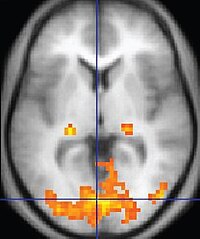
Photo from wikipedia
Biofilm infections are more difficult to treat than planktonic infections for a variety of reasons, such as decreased antibiotic penetration. Their complex structure makes biofilms challenging to study without disruption.… Click to show full abstract
Biofilm infections are more difficult to treat than planktonic infections for a variety of reasons, such as decreased antibiotic penetration. Their complex structure makes biofilms challenging to study without disruption. To address this limitation, we developed and demonstrated oxygen-sensitive luminescent nanosensors that can be incorporated into biofilms for studying oxygen penetration, distribution, and antibiotic efficacy—demonstrated here with our sensors monitoring antibiotic impacts on metabolism in biofilms formed from clinical isolates. The significance of our research is in demonstrating not only a nondisruptive method for imaging and measuring oxygen in biofilms but also that this nanoparticle-based sensing platform can be modified to measure many different ions and small molecule analytes. ABSTRACT Bacterial biofilms can form persistent infections on wounds and implanted medical devices and are associated with many chronic diseases, such as cystic fibrosis. These infections are medically difficult to treat, as biofilms are more resistant to antibiotic attack than their planktonic counterparts. An understanding of the spatial and temporal variation in the metabolism of biofilms is a critical component toward improved biofilm treatments. To this end, we developed oxygen-sensitive luminescent nanosensors to measure three-dimensional (3D) oxygen gradients, an application of which is demonstrated here with Pseudomonas aeruginosa biofilms. The method was applied here and improves on traditional one-dimensional (1D) methods of measuring oxygen profiles by investigating the spatial and temporal variation of oxygen concentration when biofilms are challenged with antibiotic attack. We observed an increased oxygenation of biofilms that was consistent with cell death from comparisons with antibiotic kill curves for PAO1. Due to the spatial and temporal nature of our approach, we also identified spatial and temporal inhomogeneities in the biofilm metabolism that are consistent with previous observations. Clinical strains of P. aeruginosa subjected to similar interrogation showed variations in resistance to colistin and tobramycin, which are two antibiotics commonly used to treat P. aeruginosa infections in cystic fibrosis patients. IMPORTANCE Biofilm infections are more difficult to treat than planktonic infections for a variety of reasons, such as decreased antibiotic penetration. Their complex structure makes biofilms challenging to study without disruption. To address this limitation, we developed and demonstrated oxygen-sensitive luminescent nanosensors that can be incorporated into biofilms for studying oxygen penetration, distribution, and antibiotic efficacy—demonstrated here with our sensors monitoring antibiotic impacts on metabolism in biofilms formed from clinical isolates. The significance of our research is in demonstrating not only a nondisruptive method for imaging and measuring oxygen in biofilms but also that this nanoparticle-based sensing platform can be modified to measure many different ions and small molecule analytes.
Journal Title: Applied and Environmental Microbiology
Year Published: 2019
Link to full text (if available)
Share on Social Media: Sign Up to like & get
recommendations!